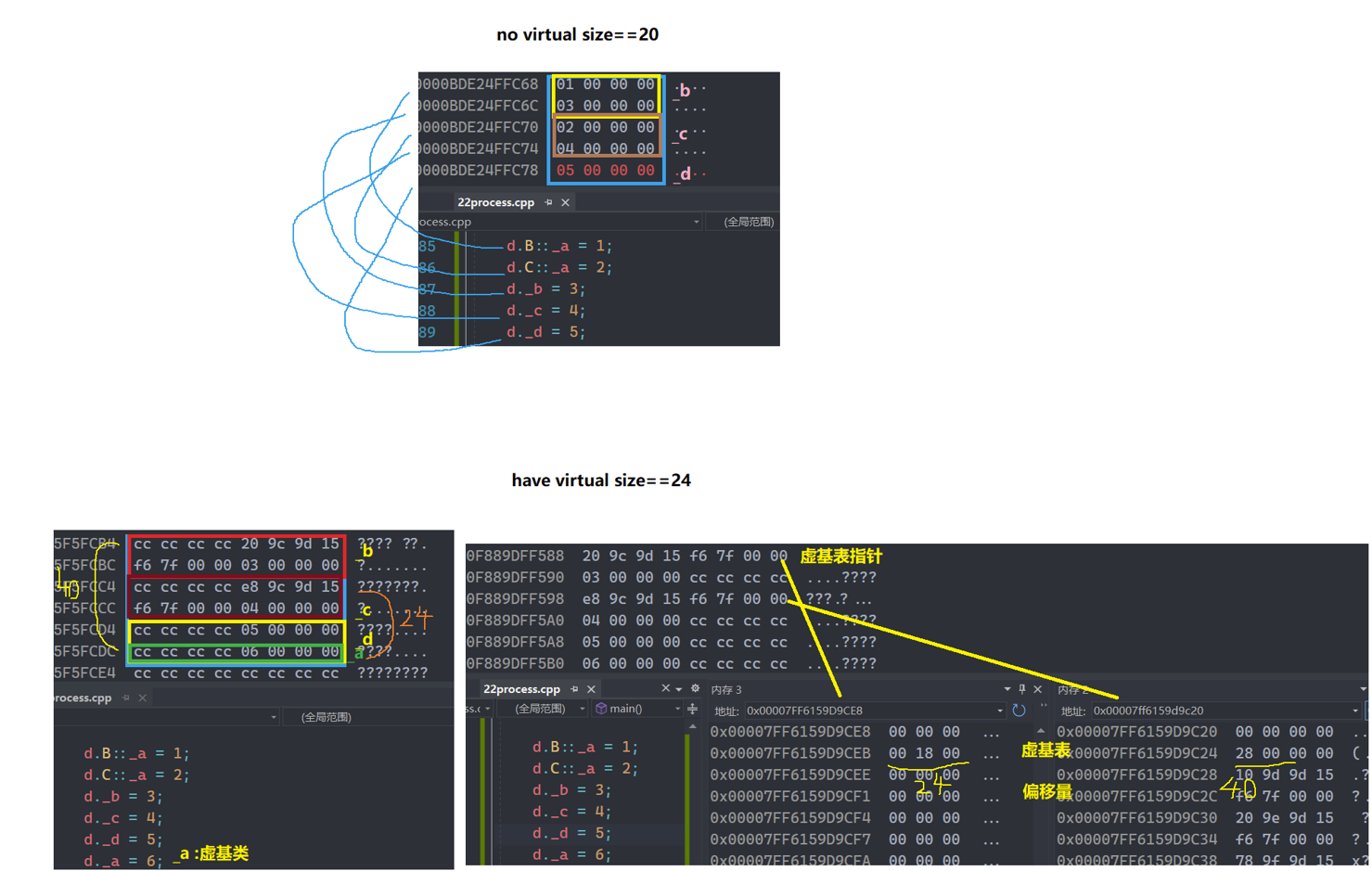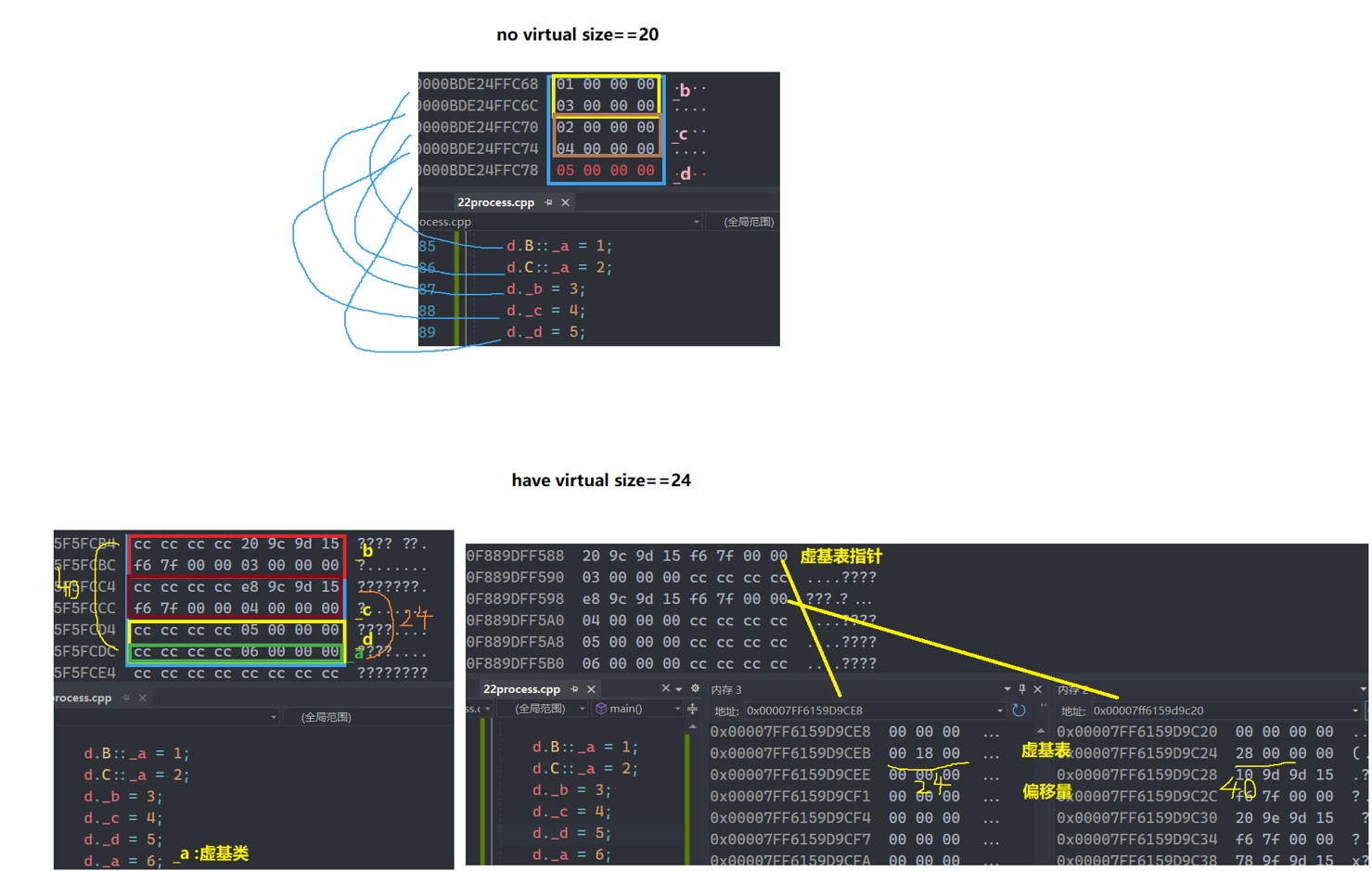一、继承方式和访问方式
注意:友元不能继承,静态成员只会在父类创造一次
父类如果用private修饰的成员,子类无法访问
protected修饰的子类可以访问,但除此之外不可访问
继承方式为private,struct为public ,一般继承方式都为public
基类的成员在子类的访问方式 = ==Min(成员在基类的访问限定符,继承方式)
二、赋值兼容规则
1
2
3
4
5
6
7
8
9
10
11
12
13
14
15
16
17
18
19
20
21
22
23
24
25
26
| int main()
{
person p;
student s;
p = s;
s = p;
person* ptr = &s;
person& ref = s;
student* sptr = (student*)&s;
sptr = (student*)&p;
sptr = dynamic_cast<student*>(ptr);
return 0;
}
|
三、默认函数的继承
1
2
3
4
5
6
7
8
9
10
11
12
13
14
15
16
17
18
19
20
21
22
23
24
25
26
27
28
29
30
31
32
33
34
35
36
37
38
39
40
41
42
43
44
45
46
47
48
49
50
51
52
53
54
55
56
57
58
59
60
61
62
63
64
65
66
67
68
69
70
71
72
73
74
75
76
77
78
79
80
81
82
83
84
85
86
| class person
{
public:
person(const char* name = "peter")
:_name(name)
{
cout << "person()" << endl;
}
person(const person& p)
:_name(p._name)
{
cout << "person(const person& p)" << endl;
}
person& operator=(const person& p)
{
cout << "person& operator=(const person& p)" << endl;
if (this != &p)
{
_name = p._name;
}
return *this;
}
~person()
{
cout << "~person()" << endl;
}
protected:
string _name;
};
class student : public person
{
public:
student(const char* name, int num)
:
person(name)
, _num(num)
{
cout << "student()" << endl;
}
student(const student& s)
:
person(s)
,_num(s._num)
{
cout << "student(const student& s)" << endl;
}
student& operator=(const student& s)
{
cout << "student& operator=(const student& s)" << endl;
if (this != &s)
{
person::operator=(s);
_num = s._num;
}
return *this;
}
~student()
{
cout << "~student()" << endl;
}
private:
int _num;
};
int main()
{
student s1("jack", 18);
student s2(s1);
student s3("rose", 19);
s1 = s3;
return 0;
}
|
四、不能被继承的类
1.将父类全部私有,使得子类无法调用父类的析构
2.利用final关键字
1
2
3
| class A final{public:A(){}};
class B :public A{};
|
五、菱形继承
1.菱形继承的问题
1
2
3
4
5
6
7
8
9
10
11
12
13
14
15
16
17
18
|
class person{};
class student : public person{};
class teacher : public student{};
class student{};
class teacher{};
class assistant : public student,public teacher{};
class person {};
class student : public person {}; class teacher : public student {};
class assistant : public student, public teacher {};
|
菱形继承时有两个问题
数据冗余:即派生类有多份相同类型的数据
二义性: 即因为有多相同类型的数据而导致对数据处理时,不知道要处理谁
1
2
3
4
5
6
7
8
9
10
11
12
13
14
15
16
17
18
19
20
21
22
23
24
25
26
27
28
29
30
31
32
33
| class person
{
public:
string _name;
};
class student :virtual public person
{
protected:
int _num;
};
class teacher :virtual public person
{
protected:
int _id;
};
class assistant : public student, public teacher
{
protected:
string _course;
};
void main()
{
assistant a;
a._name = "peter";
a.student::_name = "xxx";
a.teacher::_name = "yyy";
}
|
2.菱形继承virtual解决的原理
1
2
3
4
5
6
7
8
9
10
11
12
13
14
15
16
17
18
19
20
21
22
23
24
25
26
27
28
29
30
31
32
33
34
35
36
37
38
39
40
41
| class A
{
public:
int _a;
};
class B :virtual public A
{
public:
int _b;
};
class C :virtual public A
{
public:
int _c;
};
class D : public B, public C
{
public:
int _d;
};
int main()
{
D d;
cout << sizeof(d) << endl;
d.B::_a = 1;
d.C::_a = 2;
d._b = 3;
d._c = 4;
d._d = 5;
d._a = 6;
return 0;
}
|

六、继承和组合
1
2
3
4
5
6
7
8
9
10
11
12
13
| class A{};
class B : public A{};
class C{};
class D
{C c;};
|
一、继承方式和访问方式
注意:友元不能继承,静态成员只会在父类创造一次
父类如果用private修饰的成员,子类无法访问
protected修饰的子类可以访问,但除此之外不可访问
继承方式为private,struct为public ,一般继承方式都为public
基类的成员在子类的访问方式 = ==Min(成员在基类的访问限定符,继承方式)
二、赋值兼容规则
1
2
3
4
5
6
7
8
9
10
11
12
13
14
15
16
17
18
19
20
21
22
23
24
25
26
| int main()
{
person p;
student s;
p = s;
s = p;
person* ptr = &s;
person& ref = s;
student* sptr = (student*)&s;
sptr = (student*)&p;
sptr = dynamic_cast<student*>(ptr);
return 0;
}
|
三、默认函数的继承
1
2
3
4
5
6
7
8
9
10
11
12
13
14
15
16
17
18
19
20
21
22
23
24
25
26
27
28
29
30
31
32
33
34
35
36
37
38
39
40
41
42
43
44
45
46
47
48
49
50
51
52
53
54
55
56
57
58
59
60
61
62
63
64
65
66
67
68
69
70
71
72
73
74
75
76
77
78
79
80
81
82
83
84
85
86
| class person
{
public:
person(const char* name = "peter")
:_name(name)
{
cout << "person()" << endl;
}
person(const person& p)
:_name(p._name)
{
cout << "person(const person& p)" << endl;
}
person& operator=(const person& p)
{
cout << "person& operator=(const person& p)" << endl;
if (this != &p)
{
_name = p._name;
}
return *this;
}
~person()
{
cout << "~person()" << endl;
}
protected:
string _name;
};
class student : public person
{
public:
student(const char* name, int num)
:
person(name)
, _num(num)
{
cout << "student()" << endl;
}
student(const student& s)
:
person(s)
,_num(s._num)
{
cout << "student(const student& s)" << endl;
}
student& operator=(const student& s)
{
cout << "student& operator=(const student& s)" << endl;
if (this != &s)
{
person::operator=(s);
_num = s._num;
}
return *this;
}
~student()
{
cout << "~student()" << endl;
}
private:
int _num;
};
int main()
{
student s1("jack", 18);
student s2(s1);
student s3("rose", 19);
s1 = s3;
return 0;
}
|
四、不能被继承的类
1.将父类全部私有,使得子类无法调用父类的析构
2.利用final关键字
1
2
3
| class A final{public:A(){}};
class B :public A{};
|
五、菱形继承
1.菱形继承的问题
1
2
3
4
5
6
7
8
9
10
11
12
13
14
15
16
17
18
|
class person{};
class student : public person{};
class teacher : public student{};
class student{};
class teacher{};
class assistant : public student,public teacher{};
class person {};
class student : public person {}; class teacher : public student {};
class assistant : public student, public teacher {};
|
菱形继承时有两个问题
数据冗余:即派生类有多份相同类型的数据
二义性: 即因为有多相同类型的数据而导致对数据处理时,不知道要处理谁
1
2
3
4
5
6
7
8
9
10
11
12
13
14
15
16
17
18
19
20
21
22
23
24
25
26
27
28
29
30
31
32
33
| class person
{
public:
string _name;
};
class student :virtual public person
{
protected:
int _num;
};
class teacher :virtual public person
{
protected:
int _id;
};
class assistant : public student, public teacher
{
protected:
string _course;
};
void main()
{
assistant a;
a._name = "peter";
a.student::_name = "xxx";
a.teacher::_name = "yyy";
}
|
2.菱形继承virtual解决的原理
1
2
3
4
5
6
7
8
9
10
11
12
13
14
15
16
17
18
19
20
21
22
23
24
25
26
27
28
29
30
31
32
33
34
35
36
37
38
39
40
41
| class A
{
public:
int _a;
};
class B :virtual public A
{
public:
int _b;
};
class C :virtual public A
{
public:
int _c;
};
class D : public B, public C
{
public:
int _d;
};
int main()
{
D d;
cout << sizeof(d) << endl;
d.B::_a = 1;
d.C::_a = 2;
d._b = 3;
d._c = 4;
d._d = 5;
d._a = 6;
return 0;
}
|

六、继承和组合
1
2
3
4
5
6
7
8
9
10
11
12
13
| class A{};
class B : public A{};
class C{};
class D
{C c;};
|





